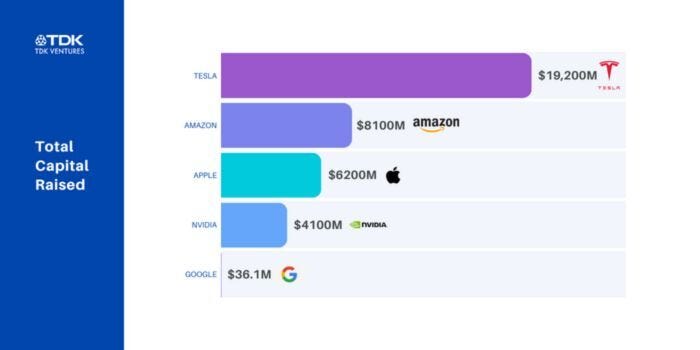In 2024, only a handful of companies worldwide boast a market capitalization exceeding $500 billion. While these companies come from a variety of industries, a majority hail from the deeptech space. This is no coincidence. Founded on cutting-edge technologies that combine physical sciences and advanced computational capability, deep tech companies like Alphabet, NVIDIA, Amazon, Tesla, Apple have the potential to revolutionize entire industries and — at the same time — command a high valuation.
It takes tremendous amount of capital to build such iconic companies. Look at the money raised from the likes of Apple, Google and Tesla before and after they went public. This type of company building is not for the faint of heart as these dollars do not come easy, especially under today’s circumstances with high interest rates (note today’s deeptech startups also need a lot more capital before IPO compared to the table below, examples are SpaceX, Relativity, Quantumscape, OpenAI, Impossible Foods, etc.). In addition, deeptech companies typically take much longer to book revenue compared to their SaaS / pure software counterparts. How can deeptech founders change the world and how do they reconcile raising so much money with such high risk?
The short answer is by building dream syndicates. So, what is a dream syndicate?
A “dream syndicate” is a consortium of investors that comprises institutional financial, strategic ecosystem players, and go-to-market specialists that are investing in an early-stage company that is going to potentially generate outsized financial returns, strategic value, and societal good.


Institutional Financial: Institutional financial VCs play a key part in deeptech startups. Their primary role involves leading rounds with a large enough check size, setting terms, governance structures, and providing the financially sound advice to founders. The financial discipline they bring often helps entrepreneurs execute their projects on time with the right level of spending to build the core capabilities of the company. Given top-tier deeptech financial VCs usually deploy larger dollars, their involvement sometimes comes with ancillary services that the entrepreneurs can utilize, like marketing support, sales, and access to talent networks. Possessing the financial rigor of institutional VCs is a must for deeptech companies.
Strategic Ecosystem Players: Most corporations involved in the deeptech space have some form of investing arm. These strategic ecosystem players in your dream syndicate often make up the front, middle, or the back end of your technology stack. For example, let’s assume the startup is commercializing a new process technology that allows an emission reducing method to manufacture lithium-ion batteries. If the business model of the startup is to sell equipment to gigafactories, then the strategic ecosystem players in the dream syndicate could be cathode, anode, makers, battery cell makers, EPC (engineering, procurement, and construction) players, system integrators, or the OEMs of EVs. Allowing such strategic players participate in the investment round not only provides access to the cutting-edge tools that they can offer, but may also help reduce the risk on supply chains, product development, scale-up, and even in manufacturing.

Go-to-market Partners: Many companies in deeptech are built from some intellectual property (IP) built at a university. These startups have tremendous knowledge in a small area of their core competency — but founders need support to bring the idea to life in the real world. For example, a startup building the next generation hydrogen electrolyzer may have built their core competency in ion exchange membranes, or electrochemical cell design, or system design of next-generation proton exchange membrane electrolyzers. However, this unique electrolyzer technology should be carefully deployed in the right market where the customer need is high or the speed to market is paramount (i.e., the right product-market fit). Finding partners who could help in deploying a prototype of the startup technology and accelerate the learning process is key to the success of the startup in progressing to the next key inflection point. In our previous electrolyzer company example, a go-to-market partner could be a collaborator aiming to produce the next generation of eco-friendly steel, ammonia, or methanol.
What are the steps to build a dream syndicate?
1. Preparedness in fundraising strategy: When we complete a dream syndicate, entrepreneurs tell us that they are much better prepared for the next round, and more importantly, they share that they now have a true understanding of inflection points, and the risks around them.
2. Building blocks towards major partnerships: Both the ecosystem partners and the go-to-market partners offer tremendous potential toward long-term partnerships. Ecosystem partners can create resilience in supply chains and offer the latest and greatest technologies in their repertoire for partnering. The go-to-market partner could offer a new channel of distribution for the startup’s product or simply speed and scale to execute if all works well in the pilot.
3. Mentorship: Many times, when we strategically approach the dream syndicate process, we get rejections. When startups go out raising using the dream syndicate process and when they can communicate their strategy cogently, we hear that the entrepreneurs get high quality feedback even when they get a “no” from an investor because of their thoughtfulness. If they say yes, this increases the chances of being mentored by a diverse range of people who have built iconic companies before.
4. Access to network of networks: Building dream syndicates opens up a much wider aperture for startups where advisors, consultants, and even future employees can be found. We went through a due diligence (DD) process with a financial VC who had an amazing IP consultant who grilled the startup on their freedom to operate. This person was so good that the Board ended up hiring him as a consultant to review their patents and put him on the startup’s patent committee. Imagine the possibilities of going through proper DD with ecosystem, go-to-market partners, these can be exhilarating learning for a startup, and potentially offer hundreds of nodal points to serious talent.
5. Increased credibility: Many entrepreneurs tell us that once we close the dream syndicate, they get customer and investor interest by looking at the logos of those who have invested in the company.
As Yan Wang, the founder of AM Batteries (and Ascend Elements) said, “the most important aspect to our growth beyond technical ideas has been the connections we’ve made along the way. TDK Ventures was quick to introduce us to key partners, both financial and strategic collaborators, and that core dream syndicate helped ensure we could continue down our current path.”
Note that not all dream syndicates pan out, nor are all investors equally helpful to the startups. However, carefully ensuring dream syndicates and building them for follow-on rounds is an art and requires patience. We do it because we have seen some great results with a few of our portfolio companies. AM Batteries, Ascend Elements and Verdagy are key examples of companies where we’ve been actively involved in building such syndicates. Our commitment is in our core value “entrepreneurs first”.
As Marty Neese, the CEO of green hydrogen system provider Verdagy said, “a key aspect of what differentiated TDK Ventures as an investor was how they first integrated us into their own key network of influence. Using those connections, they helped us establish our own dream network of financial support, market specialists, and strategic partners — a value worth more than any check.”
As they say, it takes a village to help build deeptech companies, and our dream syndicates play a small part in that iconic journey. TDK Ventures invests in companies that move the needle to benefit our society. Given TDK Ventures’ first core value is “contribution to society,” we do not want to keep this a secret and believe that sharing our methodology could help other deeptech companies change the world for good.
